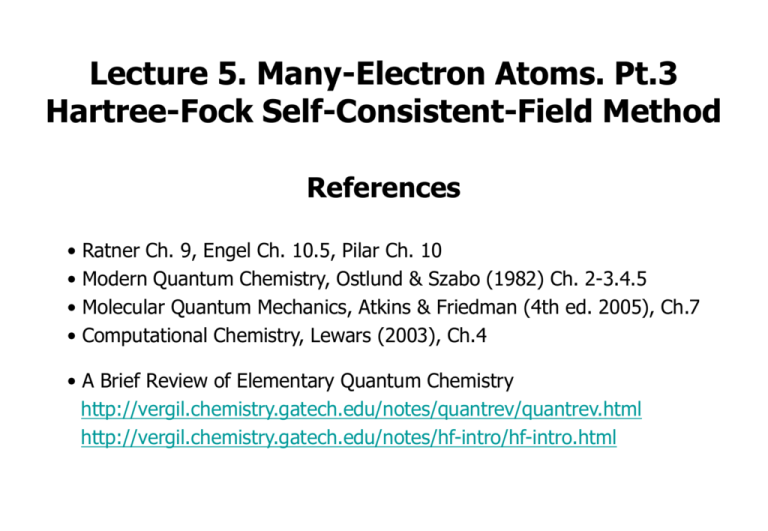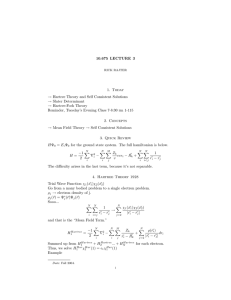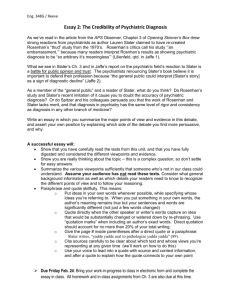Hartree-Fock equation
advertisement

Lecture 5. Many-Electron Atoms. Pt.3
Hartree-Fock Self-Consistent-Field Method
References
•
•
•
•
Ratner Ch. 9, Engel Ch. 10.5, Pilar Ch. 10
Modern Quantum Chemistry, Ostlund & Szabo (1982) Ch. 2-3.4.5
Molecular Quantum Mechanics, Atkins & Friedman (4th ed. 2005), Ch.7
Computational Chemistry, Lewars (2003), Ch.4
• A Brief Review of Elementary Quantum Chemistry
http://vergil.chemistry.gatech.edu/notes/quantrev/quantrev.html
http://vergil.chemistry.gatech.edu/notes/hf-intro/hf-intro.html
Hartree (single-particle) self-consistent-field method
based on Hartree products (D. R. Hartree, 1928)
Proc. Cambridge Phil. Soc. 24, 89
• Impossible to search through
all acceptable N-electron
wavefunctions.
• Let’s define a suitable subset.
• N-electron wavefunction
is approximated by
a product of N one-electron
wavefunctions. (Hartree product)
Nobel lecture (Walter Kohn; 1998)
Electronic structure of matter
Constrained minimization
with the Hartree product
Hartree-Fock Self-Consistent-Field Method
based on Slater determinants (Hartree+Pauli)
(J. C. Slater; V. Fock, 1930) Z. Physik, 61, 126; Phys. Rev. 35, 210
Restrict the search for the minimum E[] to a subset of , a Slater determinant.
• To build many-electron wave functions, assume that electrons are uncorrelated.
(Hartree products of one-electron orbitals)
• To build many-electron wave functions, use Slater determinants, which is all
antisymmetric products of N spin orbitals, to satisfy the Pauli principle.
• Use the variational principle to find the best Slater determinant (which
yields the lowest energy) by varying the spatial orbitals {i}.
Beyond Hartree: the ground state of He (singlet)
notation
|1s>
Slater
determinant
1s
Total spin quantum number S = Ms = 0 (singlet)
S2 (1,2) = (s1 + s2)2 (1,2) = 0, Sz (1,2) = (sz1 + sz2) (1,2) = 0
1s
1s2
Energy of the Slater determinant of the He atom:
the “singlet” ground state
spatial-symmetric spin-antisymmetric
no spin in the Hamiltonian
Coulombic repulsion between
two charge distributions
|1s(1)|2 and |1s(2)|2
Coulomb
integral
<1s|h|1s>
=<1s|T+VNe|1s>=Tss+Vs
Coulombic repulsion between two charge distributions
|1s(1)|2 and |1s(2)|2
Excited state of He (singlet and triplet states)
antisymmetric
spatial-symmetric
spinsymmetric
spatial-antisymmetric
spatial-symmetric
spatial-antisymmetric
Energy of the Slater determinant of the He atom:
a “triplet” first excited state
triplet
singlet
? (quiz)
Coulomb integral > 0
where
Exchange integral (>0)
includes in it
wave function
(final solution)!
Energy of the Slater determinant of the He atom:
a “triplet” first excited state
triplet
singlet
Coulomb integral > 0
where
Exchange integral (>0)
includes in it
wave function
(final solution)!
Two-electron interactions (Vee)
• Coulomb integral Jij (local)
> 0, i.e., a destabilization
Coulombic repulsion between electron 1 in orbital i and electron 2 in orbital j
• Exchange integral Kij (non-local) only for electrons of like spins
No immediate classical interpretation; entirely due to antisymmetry of fermions
Each term includes the wave
function (the final solution) in it!
Hartree-Fock Self-Consistent-Field Method
based on Slater determinants (Hartree+Pauli)
(J. C. Slater & V. Fock, 1930)
• Each has variational parameters (to be changed to minimize E) including the
effective nuclear charge (instead of the formal nuclear charge Z)
or its combination for lower E
• Variational condition
= ij
• Variation with respect to the one-electron orbitals {i}, which are orthonormal
Constrained (due to the orthonormality of {i})
minimization of EHF[SD] leads to the HF equation.
vergil.chemistry.gatech.edu/notes/hf-intro/node7.html ; Pilar Ch.10.1, Ostlund/Szabo Ch.1.3
Constrained minimization with the Slater determinant
After constrained minimization with the Slater determinant
Hartree-Fock equation (one-electron equation)
Fock operator: “effective” one-electron operator
Two-electron repulsion operator (1/rij) is replaced by one-electron operator VHF(i),
which takes it into account in an “average” way
&
Two-electron repulsion cannot be separated exactly into one-electron terms.
By imposing the separability, the orbital approximation inevitably involves
an incorrect treatment of the way in which the electrons interact with each other.
Hartree-Fock Self-Consistent Field (HF-SCF) Method
Problem:
•Fock operator (V) depends on the solution.
•The answer (solution) must be known
in order to solve the problem!
•HF is not a regular eigenvalue problem that
can be solved in a closed form.
Solution (iterative approach):
1.Start with a guessed set of orbitals.
2.Solve the Hartree-Fock equation.
3.Use the resulting new set of orbitals
in the next iteration and so on
4.Until the input and output orbitals
differ by less than a preset threshold
(i.e. converged to a self-consistent field).
Hartree-Fock equation (One-electron equation)
spherically symmetric
Veff includes
&
- Two-electron repulsion operator (1/rij) is replaced by one-electron operator VHF(i),
which takes it into account in an “average” way.
- Any one electron sees only the spatially averaged
position of all other electrons.
- VHF(i) is spherically symmetric.
- (Instantaneous) electron correlation
is ignored.
- Spherical harmonics (s, p, d, …) are valid
angular-part eigenfunction (as for H-like atoms).
- Radial-part eigenfunction of H-like atoms are not valid any more.
optimized
Electron Correlation
Ref) F. Jensen, Introduction to Computational Chemistry, 2nd ed., Ch. 4
• A single Slater determinant never corresponds to the exact wave
function.
EHF > E0 (the exact ground state energy)
• Correlation energy: a measure of error introduced through the HF scheme
EC = E0 - EHF (< 0)
– Dynamical correlation
– Non-dynamical (static) correlation
• Post-Hartree-Fock method
– Møller-Plesset perturbation: MP2, MP4, …
– Configuration interaction: CISD, QCISD, CCSD, QCISD(T), MCSCF, CAFSCF, …
Solution of HF-SCF equation gives
Solution of HF-SCF equation:
Effective nuclear charge
(Z- is a measure of shielding.)
Aufbau (Building-up) principle






![Page 1, [Multiple Forms]](http://s3.studylib.net/store/data/008926863_1-f47e3386c0647d8946d7b22a41b33117-300x300.png)
